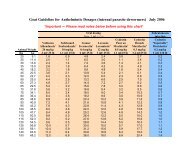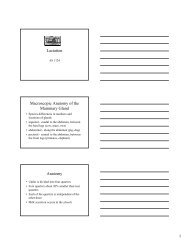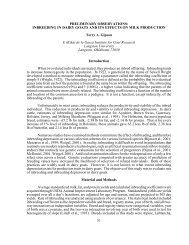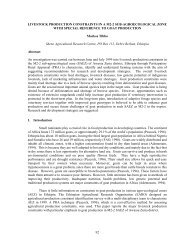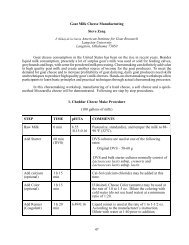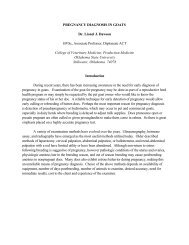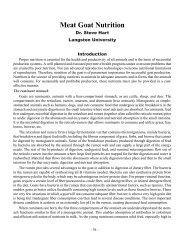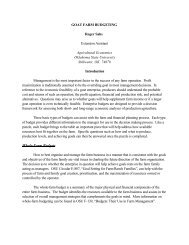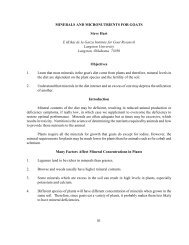Forage Based Dairy Goat Management - Langston University ...
Forage Based Dairy Goat Management - Langston University ...
Forage Based Dairy Goat Management - Langston University ...
Create successful ePaper yourself
Turn your PDF publications into a flip-book with our unique Google optimized e-Paper software.
FORAGE BASED DAIRY GOAT MANAGEMENT<br />
Steven P. Hart and B. R. Min<br />
E (Kika) de la Garza Institute for <strong>Goat</strong> Research<br />
<strong>Langston</strong> <strong>University</strong><br />
<strong>Langston</strong>, Oklahoma 73050<br />
Pastures have not typically been utilized for milk production with dairy goats. Well, goats<br />
have been put on pastures, but for the most part, pastures have not been managed to be the major<br />
source of high quality forage for the dairy goats. Often, pastures were not fertilized and allowed to<br />
mature. <strong>Goat</strong>s were usually fed hay and they nibbled some pasture as they wanted to. There is little<br />
published information about pastures for goats - a little from Mexico on brushy pastures with low<br />
levels of milk production and some from France which is in French. Nonetheless, there are a few<br />
goat producers in the US who are utilizing pasture for their milking goats.<br />
Most of the information available for dairy production on pastures comes from dairy cow<br />
research. There has been a renaissance in pastures for dairy cows, mostly with the smaller dairies.<br />
The chief reason for going to pastures is reduced feed costs and increased profitability of the<br />
operation even though milk production levels are reduced. One economic study showed that<br />
pasturing dairy cows improved profitability as much as using bovine growth hormone. Another<br />
benefit of pasturing has been improved animal health and reduced health expenses. This is probably<br />
a consequence of reduced production level and animal stress and the benefit of sunshine and fresh<br />
air. However, the level of management required is much higher because the pastures must be<br />
managed as intensively as the animals. An additional benefit is less barn cleaning and less time<br />
required to take care of animals since the time required for feeding is reduced.<br />
Some international literature has shown that pasture can affect the quality and flavor of<br />
cheese made from cow milk. There is virtually no work on this subject in dairy goats. Another<br />
potential benefit is that the concentration of conjugated linoleic acid in cow milk is increased by<br />
pasture. The less grain used, the greater the concentration of conjugated linoleic acid. Conjugated<br />
linoleic acid is a compound in milk that has been identified as being anticarcinogenic (prevents<br />
cancer)and antiatheroschlerotic (prevents the clogging of arteries). It is the only animal product that<br />
has been identified as an anticarcinogen. Also, since organic grain is very expensive, organic goat<br />
milk could be produced cheaper on organic pasture since a minimum of grain would be required.<br />
Pasture management is of paramount importance if milk production from pastures is to<br />
succeed. The goal of pasture management is to supply high quality pasture starting at the beginning<br />
of lactation and maintain high quality forage in sufficient quantities throughout the lactation. The<br />
forage must be high in quality and be available when animals are lactating. Unless you are quite far<br />
south, you are unlikely to have any pasture growing between mid-December and mid-March.<br />
Therefore, it would be difficult to have pasture for kidding in February. For most of Oklahoma, cool<br />
season annuals such as wheat start producing in mid-March and kidding should be timed<br />
accordingly. Wheat and other cool season annuals (rye, oats) have the high quality that is necessary<br />
for high levels of milk production. Alfalfa is a good high quality pasture, but has the disadvantage<br />
of being later in the season (grazing beginning mid-April) and high cost of pasture establishment.<br />
Outside of alfalfa, goats like few legumes. In our experience, goats eat little of white, red, crimson,<br />
or arrowleaf clover. However, they seem to love Berseem clover, which can be overseeded with<br />
wheat. Berseem clover provides high quality forage between wheat and crabgrass. We have<br />
multiple pastures of wheat and Berseem clover. In late spring, we disk a pasture every week or two<br />
and overseed crabgrass/sudan grass into them. By staggering the planting, we can have an<br />
36
uninterrupted supply of high quality forage. Crabgrass is one of the highest quality warm season<br />
grasses. There are a number of other warm season grasses that are appropriate, including<br />
Johnsongrass, millet, and sudangrass. We are planning on including annual lespedeza into our warm<br />
season pastures. We have begun using cowpeas for late summer grazing. They grow well in the hot<br />
dry summer and provide high quality forage that the goats relish.<br />
One needs to adjust to the grazing behavior of goats. Initially, when goats were put to<br />
pasture, they bawled for the barn and alfalfa hay. After 4 or 5 days, they finally decided to accept<br />
their fate and put their heads down to graze. We have had to learn which forages dairy goats do well<br />
on and which ones are not appropriate. Initially, the goats did not like the cowpeas, but after 4 or<br />
5 days, they decided they loved them. <strong>Goat</strong>s love the Berseem clover. Water is provided in each<br />
pasture. It would be good if the water could be shaded in the hot summer to keep the water and goats<br />
cooler. Also, a portable shade is provided. It was built on a hay wagon undergear and has a<br />
corrugated metal roof about 8' off the ground and is 12 × 24', which provides sufficient shade for 50-<br />
60 goats. It was our intent to put a mineral box on the portable shade. We are experimenting with<br />
other crops for milking goats such as Puna chicory. Crops meriting investigation include perennials<br />
such as orchardgrass, which would improve sustainablility and reduce tillage needs.<br />
We have conducted two years of research grazing dairy goats. This study also involved<br />
different levels of grain supplementation. Milk production for these two years are shown in Figure<br />
1. This is averaged over all levels of grain which will be discussed later. The lactation curves look<br />
fairly normal, but milk production is much lower for the first year than the second year. This can<br />
be attributed to three factors. First, goats were in lower body condition in year 1 and did not have<br />
adequate body reserves for the following lactation. Another factor was that we had some gaps in our<br />
forage system, i.e., there were some times that we did not have adequate amounts of high quality<br />
forage available for grazing. Also, we had problems with internal parasites the first year that<br />
surprised us. The problem was that the dewormer that we used did not work. Since animals in the<br />
confinement part of our operation are on concrete during lactation, they do not pick up many internal<br />
parasites and therefore we did not realize that the dewormer was not working. Does were pastured<br />
October through early March when cold weather reduced parasite problems. We did not realize that<br />
our dewormer was not working until we grazed goats during the warm, moist spring. We learned<br />
from our mistakes the first year and had much better levels of milk production the second year.<br />
Internal parasites are one of the biggest problems in using pastures for dairy goats. The first<br />
problem is that you are limited in that which dewormers can be used for lactating animals (Panacur,<br />
Valbazen, Eprinex, and Rumatel). We have dewormer resistance to the first two dewormers, but the<br />
latter two dewormers are quite effective for us. Ivermectin and Cydectin are secreted in the milk for<br />
a long time and should never be used in lactating animals. Fecal egg counts must be done every 3<br />
weeks to stay on top of the parasite problem. <strong>Dairy</strong> does should be dewormed when fecal egg<br />
counts exceed 800 eggs per gram. Pasture rotation and the tillage of pastures helps to reduce pasture<br />
contamination. Another practice that would be useful is grazing another animal species (such as<br />
horses or cattle) on the pasture following the goats. These animals would consume the larvae and<br />
clean up the pastures. Another practice that reduces larva contamination is to make hay after<br />
grazing.<br />
Table 1 shows the effect of different levels of grain supplementation on milk production.<br />
We calculated that animals should be able to consume enough pasture to produce about 3.3 lb of<br />
milk per day and planned on three levels of grain supplementation for milk produced above this<br />
amount. One treatment had no supplemental grain such as one may use if organic milk or high CLA<br />
milk is to be produced (treatment D). The second grain level was 1/3 lb of grain for every lb of milk<br />
over 3.3 lbs (treatment C), and the third level was 2/3 lb of grain for every lb of milk over 3.3 lbs<br />
(treatment B). Treatment A is our control where animals are in the barn and fed alfalfa hay and grain<br />
37
at the same level as treatment B. We fed an additional pound of grain to treatments A, B, and C the<br />
first 8 wk of lactation as lead feeding. Does were limited to no more than 4.4 lb of grain per day to<br />
prevent acidosis. In the first year, milk yield declined with grazing and grain level, although as<br />
discussed previously, prekidding body condition was an important factor. In the second year, milk<br />
production of grazing goats with the lower level of grain supplementation was similar to control<br />
animals in the barn. It is not known why the higher level of grain supplementation produced lower<br />
levels of milk. Also in Table 1, the lactation curve characteristics for each treatment and year are<br />
shown. Does in year 1 had lower peak yields, especially with lower levels of grain because the peak<br />
yield occurred earlier than in the second year. Milk yields peaked earlier because does exhausted<br />
body reserves sooner since they had lower body condition. Persistency (ability to sustain milk<br />
production) was also lower for goats fed lower levels of grain. In the second year when does were<br />
in better body condition, milk yield peaked at similar levels for all treatments. Peak yield tended to<br />
occur earlier in the goats being fed pasture alone, probably a consequence of energy limitation.<br />
Persistency of all treatments was similar during the second year. Milk production responded to<br />
grain, but not dramatically. Figure 2 shows that milk production increased by 1.7 lb for every added<br />
pound of grain supplement fed. Also, it shows that animals were able to produce about 3.3 lb of<br />
milk with no grain, although, some animals on the study did much better.<br />
Fat percentage of milk tended to be lower for animals with no grain supplementation (Table<br />
1), probably reflecting the energy restriction of animals on this diet. Protein and lactose followed<br />
a similar trend presumably for the same reason. Despite this limitation, cheese made from milk<br />
produced on pasture alone or with the low level of grain was shown to have higher flavor scores.<br />
In conclusion, dairy goats on pasture can have acceptable levels of milk production with<br />
some minor changes in milk composition, especially where grain supplementation is absent. Grazing<br />
dairy goats requires additional management demands, especially for the pasture. In areas with quite<br />
dry summers, irrigation may be necessary to insure an uninterrupted supply of forage. Internal<br />
parasites need to be monitored and controlled. For the production of organic milk or high milk high<br />
in conjugated linoleic acid, goats may produce significant levels of milk from high quality pasture<br />
alone. Pasture may offer potential for producing cheese with unique flavors.<br />
38
12<br />
Milk production (lbs)<br />
10<br />
8<br />
6<br />
4<br />
2<br />
0<br />
March<br />
17-Apr<br />
27-Apr<br />
7-May<br />
17-May<br />
30-May<br />
6-Jun<br />
26-Jun<br />
6-Jul<br />
26-Jul<br />
5-Aug<br />
8-Aug<br />
Month<br />
2000 2001<br />
Figure 1. Lactation curve for dairy goats over two years<br />
Milk production (lbs)<br />
18<br />
16<br />
14<br />
12<br />
10<br />
8<br />
6<br />
4<br />
2<br />
0<br />
y = 1.7158x + 3.3222<br />
r = 0.6; n=199; P
Table 1. Milk production of grazing goats with different levels of grain supplementation<br />
_________________________________________________________________________________<br />
Treatment<br />
__________________________________________<br />
Item Year A B C D<br />
_________________________________________________________________________________<br />
Milk production (lb/day) 1 7.55 a 6.47 b 5.65 c 4.73 d<br />
2 8.91 a 8.05 b 9.17 a 7.74 b<br />
Lactation peak (lb/day) 1 8.8 a 8.1 b 7.7 b 7.3 b<br />
2 12.1 10.3 11.2 10.1<br />
Days to peak 1 44 a 32 b 32 b 22 c<br />
2 41 37 40 36<br />
Persistency 1 6.52 a 6.18 b 6.06 b 5.64 c<br />
2 6.34 6.32 6.37 6.22<br />
Composition<br />
Milkfat (%) 1 3.11 3.16 3.17 3.03<br />
2 3.23 a 3.16 a 3.11 a 2.99 b<br />
Protein (%) 1 3.05 a 3.12 b 3.19 b 3.04 a<br />
2 3.18 a 3.07 b 3.01 b 2.80 c<br />
Lactose (%) 1 4.09 a 4.14a 4.10 a 3.99 b<br />
2 4.16 b 4.24 a 4.19 b 4.00c<br />
_________________________________________________________________________________<br />
*<br />
Treatment A = control group confined in the barn and fed alfalfa hay supplemented with 2/3<br />
lb of grain for each pound of milk over 3.3 lb/day; Treatment B = grazed on pasture and<br />
supplemented with 2/3 lb of grain for each pound of milk over 3.3 lb/day; Treatment C = grazed on<br />
pasture and supplemented with 1/3 lb of grain for each pound of milk over 3.3 lb/day; Treatment D<br />
= grazed on pasture alone, no grain supplementation.<br />
a,b,c Means without a common superscript are significantly different (P < 0.05).<br />
40
The proper citation for this article is:<br />
Hart, S. P. and B. R. Min. 2002. <strong>Forage</strong> <strong>Based</strong> <strong>Dairy</strong> <strong>Goat</strong> <strong>Management</strong>. Pages 36-40<br />
in Proc. 17th Ann. <strong>Goat</strong> Field Day, <strong>Langston</strong> <strong>University</strong>, <strong>Langston</strong>, OK.



